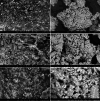Bacillus megaterium favours CO₂ mineralization into CaCO₃ over the ureolytic pathway
- PMID: 40594585
- PMCID: PMC12216158
- DOI: 10.1038/s41598-025-07323-9
Bacillus megaterium favours CO₂ mineralization into CaCO₃ over the ureolytic pathway
Abstract
Microbially induced calcite precipitation (MICP) has long been the focus of material scientists, environmental microbiologists and civil engineers because of its potential to yield biosynthesized binders that can serve as alternatives to cement or resins. Several microbial strains play crucial roles in this process and catalyse pathways for the formation of minerals, which are believed to substantially reduce the environmental impact of building materials and activities. Among the studied strains, Bacillus megaterium is not as common as Sporosarcina species. The latter microorganisms are well known to drive the fastest ureolytic-driven MICP process, i.e., precipitation of CaCO3 after urea breakdown into carbonate and CaCl2 addition to the system. This paper sheds light on the activities of B. megaterium, which possesses dual enzymatic capabilities for MICP and is equipped with both the enzymes urease and carbonic anhydrase. We postulate that, depending on the growth conditions, B. megaterium can activate either of these genes to ultimately induce CaCO3 precipitation. Herein, experiments are carried out in open and closed systems. C13-labelled urea is employed to identify the carbon source in the precipitated CaCO3. The results from Fourier transform infrared spectroscopy (FTIR) revealed the precipitation of calcite. In the presence of urea and CO2 at atmospheric levels, B. megaterium activates the ureolytic pathway to perform urea hydrolysis. However, at increased CO2 levels, more precisely, at levels greater than 470 times the atmospheric level, carbonic anhydrase is activated, catalysing the hydration of the molecule to produce HCO3-. When C13-labelled urea was utilized, only 6% of the precipitated CaCO3 mineral was linked to ureolysis, and it was found that the remaining 94% was formed due to the mineralization of CO2. Overall, in this work, we aim to introduce the process conditions and protocols that favour the sequestration of atmospheric CO2 as CaCO3 via the metabolic activities of B. megaterium.
© 2025. The Author(s).
Conflict of interest statement
Declarations. Competing interests: The authors declare that there are no competing interests related to this publication. The research, analysis, and findings presented are independent of any financial, professional, or personal relationships that could influence the content or interpretation of the results.
Figures




Similar articles
-
Assessment of ecofriendly carbon capture using Bacillus subtilis induced calcium carbonate precipitation with focus on applications mechanisms and cost efficiency.Sci Rep. 2025 Jul 1;15(1):21906. doi: 10.1038/s41598-025-06688-1. Sci Rep. 2025. PMID: 40594560 Free PMC article.
-
Thermophiles in nanosized biocalcification: a novel approach for heavy metal remediation.Biometals. 2025 Aug;38(4):1203-1221. doi: 10.1007/s10534-025-00700-x. Epub 2025 May 24. Biometals. 2025. PMID: 40411706
-
Genomic Analysis and Biomineralization Efficacy of Bacillus megaterium SS3 for Improving Durability Properties of Building Material.Mol Biotechnol. 2025 Aug 7. doi: 10.1007/s12033-025-01491-9. Online ahead of print. Mol Biotechnol. 2025. PMID: 40773149
-
Microbially Induced Calcium Carbonate Precipitation by Sporosarcina pasteurii: a Case Study in Optimizing Biological CaCO3 Precipitation.Appl Environ Microbiol. 2023 Aug 30;89(8):e0179422. doi: 10.1128/aem.01794-22. Epub 2023 Jul 13. Appl Environ Microbiol. 2023. PMID: 37439668 Free PMC article. Review.
-
Systemic pharmacological treatments for chronic plaque psoriasis: a network meta-analysis.Cochrane Database Syst Rev. 2021 Apr 19;4(4):CD011535. doi: 10.1002/14651858.CD011535.pub4. Cochrane Database Syst Rev. 2021. Update in: Cochrane Database Syst Rev. 2022 May 23;5:CD011535. doi: 10.1002/14651858.CD011535.pub5. PMID: 33871055 Free PMC article. Updated.
References
-
- Phillips, A. J. et al. Engineered applications of ureolytic biomineralization: a review. Biofouling29 (6), 715–733 (2013). - PubMed
-
- Terzis, D. & Laloui, L. A decade of progress and turning points in the understanding of bio-improved soils: A review. Geomechanics for Energy and the Environment, 19, p.100116. (2019).
-
- Mori, D. & Uday, K. V. A review on qualitative interaction among the parameters affecting ureolytic microbial-induced calcite precipitation. Environmental Earth Sciences, 80(8), p.329. (2021).
-
- Harran, R., Terzis, D. & Laloui, L. Mechanics, modeling, and upscaling of biocemented soils: a review of breakthroughs and challenges. International Journal of Geomechanics, 23(9), p.03123004. (2023).
MeSH terms
Substances
Grants and funding
- 02.649 IP-ENGMiBOC/Innosuisse - Schweizerische Agentur für Innovationsförderung
- 02.649 IP-ENGMiBOC/Innosuisse - Schweizerische Agentur für Innovationsförderung
- 02.649 IP-ENGMiBOC/Innosuisse - Schweizerische Agentur für Innovationsförderung
- 02.649 IP-ENGMiBOC/Innosuisse - Schweizerische Agentur für Innovationsförderung
LinkOut - more resources
Full Text Sources

